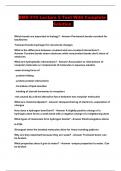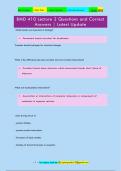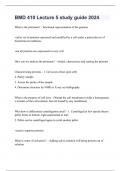Bmd 410 lecture 2 - Study guides, Class notes & Summaries
Looking for the best study guides, study notes and summaries about Bmd 410 lecture 2? On this page you'll find 5 study documents about Bmd 410 lecture 2.
All 5 results
Sort by

-
BMD 410 Lecture 2 Test With Complete Solution
- Exam (elaborations) • 2 pages • 2024
- Available in package deal
-
- $9.99
- + learn more
BMD 410 Lecture 2 Test With Complete Solution ...

-
BMD 410 Lecture 2 Questions and Correct Answers | Latest Update
- Exam (elaborations) • 5 pages • 2024
-
- $9.99
- + learn more
Which bonds are important in biology? Permanent bonds-covalent for backbones Transient bonds-hydrogen for structural changes What is the difference between covalent and non-covalent interactions? Covalent bonds share electrons while noncovalent bonds don't share of electrons What are hydrophobic interactions? Association or interactions of nonpolar molecules or components of molecules in aqueous solution -main driving force of -protein folding -protein protein interac...

-
BMD 410 Lecture 5 study guide 2024
- Exam (elaborations) • 6 pages • 2024
- Available in package deal
-
- $13.99
- + learn more
What is the proteome? - functional representation of the genome -entire set of proteins expressed and modified by a cell under a particular set of biochemical conditions. -not all proteins are expressed in every cell How can we analyze the proteome? - Isolate, characterize and catalog the proteins Characterizing proteins - 1. Get access (bust open cell) 2. Purify sample 3. Assess the purity of the sample 4. Determine structure by NMR or X-ray crystallography What is the purpose...

-
BMD 410 Lecture 2 exam guide 2024
- Exam (elaborations) • 3 pages • 2024
- Available in package deal
-
- $13.99
- + learn more
Which bonds are important in biology? - Permanent bonds-covalent for backbones Transient bonds-hydrogen for structural changes What is the difference between covalent and non-covalent interactions? - Covalent bonds share electrons while noncovalent bonds don't share of electrons What are hydrophobic interactions? - Association or interactions of nonpolar molecules or components of molecules in aqueous solution -main driving force of -protein folding -protein protein interactions ...
Package deal for BMD 410 Lecture 5 study guide 2024

That summary you just bought made someone very happy. Also get paid weekly? Sell your study resources on Stuvia! Discover all about earning on Stuvia


